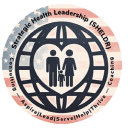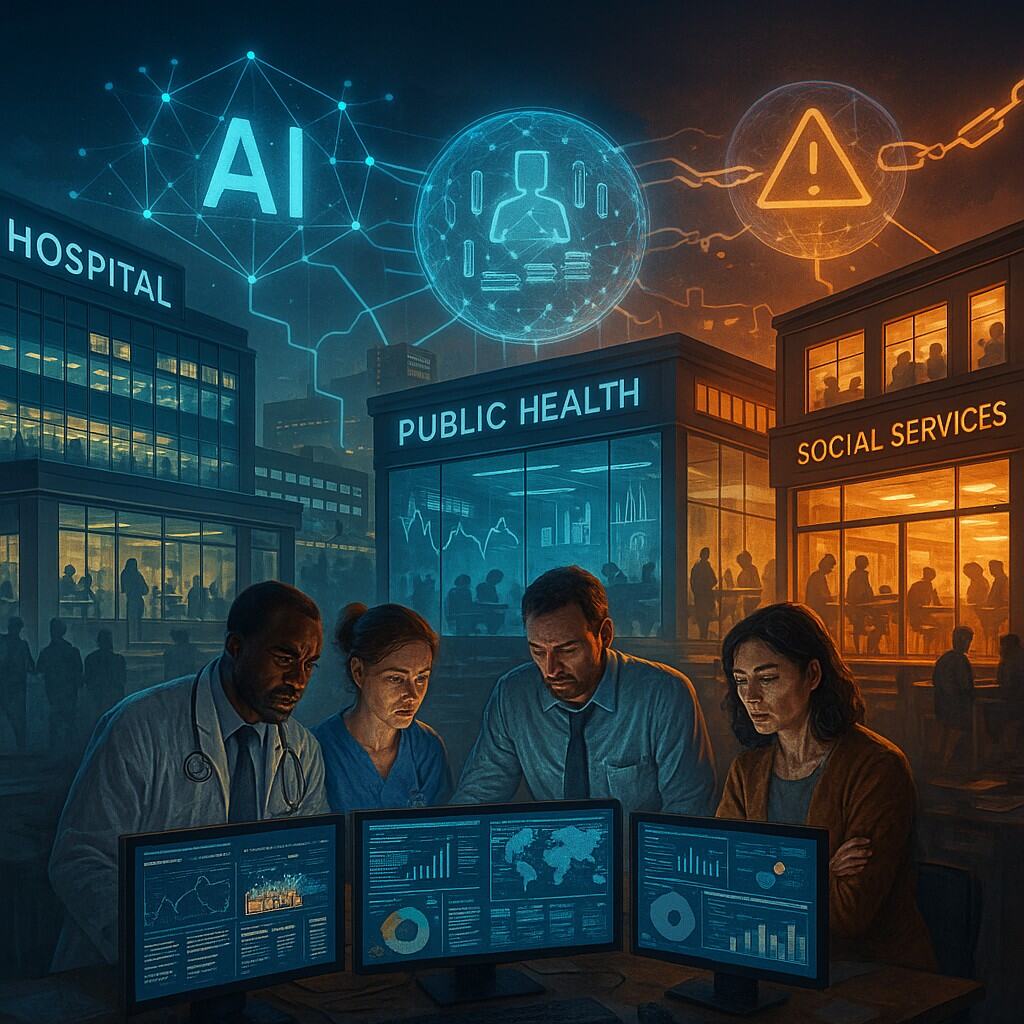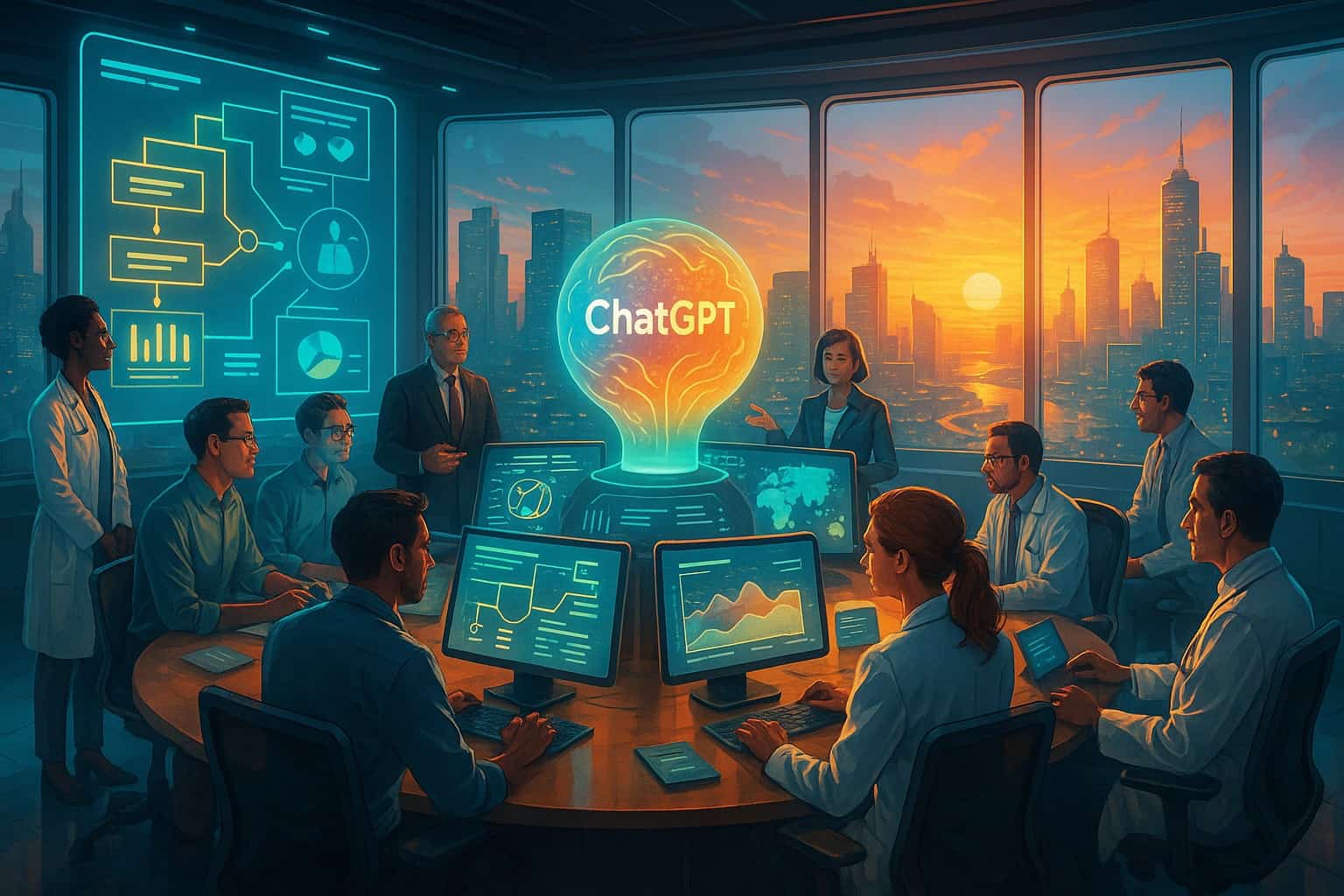Table of Contents
What if your next strategic decision in healthcare could be faster, fairer, and wiser—with AI as your thinking partner?
Discover 15 powerful ways ChatGPT transforms leadership decisions across health and human services with smarter, faster, and more ethical AI integration.
Executive Summary: Upstream Strategic health leadership (SHELDR) is evolving fast. This two-part article reveals how generative AI—especially ChatGPT—elevates decision-making through 15 proven frameworks. Part 1 focuses on the strategic and conceptual foundation–why leadership must evolve. Part 2 concentrates on tactical and applied tools–how to do it). From the WRAP method to the OODA loop, leaders learn to merge evidence, ethics, and empathy to make faster, smarter, and more transparent choices. Each framework includes real-world health examples, showing how AI improves insight, accountability, and adaptability. This guide bridges leadership science and practical AI use—equipping professionals to lead with clarity, courage, and conscience. To learn more, use the links, questions, learning activities, and references.
Part I: The Case for AI-Ready Leadership and the Power of Intentional Strategy
Health and human services leaders stand at a crossroads. Artificial intelligence has the power to transform healthcare operations, yet many organizations remain trapped in a pattern of reactive adoption—purchasing tools without the strategy to use them effectively. AI will not save a broken system; it will simply accelerate its dysfunction. The future of leadership lies not in chasing algorithms but in mastering judgment—combining strategic foresight with technological fluency. The next generation of leaders must treat AI as a strategic assistant, not a savior, and build the skills to align it with mission, ethics, and measurable outcomes.
Transforming Health Leadership with ChatGPT Decision Power
Health leaders today face extraordinary pressure to make complex, time-sensitive choices that affect patient outcomes, workforce well-being, and financial sustainability. The difference between success and crisis often lies in how decisions are structured, evaluated, and acted upon. Artificial intelligence—especially generative AI models like ChatGPT—is transforming that process. It allows leaders to integrate data, ethics, and experience into clear, confident decisions.
The real breakthrough comes when AI becomes not a replacement for judgment but a coach for better thinking. Generative AI supports critical analysis, challenges bias, and helps leaders test assumptions before committing resources. According to Deloitte (2023), over 75% of healthcare organizations are now scaling AI across operations, yet fewer than half have leaders trained to integrate it into structured decision frameworks. This gap creates risk—and opportunity. Leaders who learn to combine AI with proven frameworks like WRAP, OODA, and SPADE can dramatically improve their clarity, speed, and foresight.
Building on this context, recent trends show momentum. According to the 2023 Deloitte Center for Health Solutions Report, health care organizations are recognizing the potential of Generative AI. First, 75% of leading health care companies are experimenting with or planning to scale Generative AI across the enterprise. Second, 82% have or plan to implement governance and oversight structures for Generative AI. Finally, health leaders see promise in Generative AI for improving efficiencies (92%) and enabling quicker decision-making (65%).
This growing interest in generative AI sets the stage for a closer look at its decision-support potential. This article conducts a critical synthesis of 15 established CEO decision-making frameworks, advancing a novel perspective on their applicability within the unique context of health and human services leadership. By systematically integrating ChatGPT into these frameworks, the article not only illustrates enhancement strategies but also interrogates the dynamic potential of generative AI to transcend conventional human judgment. Each framework is explored as a multidimensional tool that enables robust option generation, systematic evaluation of underlying assumptions, risk mitigation, and the incorporation of multiple stakeholder perspectives.
Furthermore, by fostering unbiased, evidence-based analysis and ensuring coherence between immediate and long-term organizational objectives, these frameworks, when augmented by ChatGPT offer a comprehensive, methodologically rigorous toolkit. The inclusion of thoroughly vetted sources for each approach further substantiates their credibility, equipping health leaders with both practical efficacy and scholarly legitimacy.
Health and human services leaders regularly make complex, high-stakes decisions. To address these challenges, organizations are adopting established decision-making frameworks and leveraging generative AI like ChatGPT. AI improves human judgment, not replaces it, by giving us data-driven insights, questioning our assumptions, and speeding up analysis. As an example, a review in JAMA Surgery suggests using AI to help doctors make difficult clinical decisions, which would lower bias and stop mistakes.
Clinical teams used to manually analyze patient data, which was time-consuming and biased. AI-powered ChatGPT quickly processes data and finds patterns, providing teams with unbiased analysis. This integration speeds decision-making and reduces bias by supplementing human expertise. This integration expedites decision-making and reduces bias by complementing human expertise. For example, combining AI with surgeons judgment improves risk identification, informed consent, and resource planning.
Health leaders today are exploring how to harness AI’s strengths–rapid data processing, pattern recognition, unbiased feedback–within established decision frameworks to drive better outcomes. According to a Health Affairs commentary, generative AI can support core public health functions by improving communication, optimizing organizational performance, and generating novel insights to drive decision making.
Why Intentional AI Strategy Defines the Next Era of Leadership
AI adoption without strategy amplifies inefficiency. Automation applied to broken workflows simply magnifies existing chaos. To address these needs, IBM urges building a solid AI strategy. AI is a tool to be learned, used, and managed. In healthcare, it boosts leadership vision but doesn’t replace it. Top leaders use AI to meet clear goals, not as a quick fix. The best question isn’t “Which AI tool should we buy?” but “Which outcomes are we trying to improve?” When aligned with goals like improving patient experience or care coordination AI becomes powerful.
AI may not resolve issues that are already problematic. In some cases, automation can exacerbate existing challenges. Before implementing AI, leaders should consider making workflows more efficient and clarify roles. A solid foundation allows technology to support improvements, rather than contribute additional confusion. For example, a hospital that implemented AI before fixing its scheduling system experienced increased scheduling problems, staff frustration, and longer wait times for patients. It could be beneficial to first streamline processes before adopting AI. Infrastructure, data, workforce, governance, and ethics might all be included in a strategic plan for effective AI integration and long-term advantage.
To assist in this transformation, leaders can use a readiness assessment checklist to determine if their systems are prepared for AI integration. Here are several key points to consider:
- Assess Current Processes: Are all existing workflows documented and optimized?
- Infrastructure Evaluation: Do you have adequate technology infrastructure supporting AI systems?
- Data Quality Check: Is your data clean, accurate, and accessible?
- Workforce Readiness: Is your team trained to work effectively with AI tools?
- Governance Structures: Are there clear governance and oversight protocols in place for AI use?
- Ethical Considerations: Have you addressed the ethical implications of AI in your operations?
By systematically addressing these areas, health leaders can ensure a more seamless and strategic introduction of AI into their operations.
Once foundational structures are in place, integration across functions rather than silos maximizes AI value. Finance, operations, care, and community initiatives benefit from AI integration. A coordinated tool ecosystem works better than a single solution. Clear goals, processes, and integration make AI valuable. Leaders must also improve decision-making speed. The following fifteen tools help leaders use AI to improve judgment and lead confidently.
Reimagining Leadership: How AI Elevates Every Decision
To further illustrate the practical benefits of integrating generative AI into health leadership, the next section provides decision tools accompanied by health-specific examples that highlight the collaborative potential between leaders and ChatGPT. Each framework is contextualized through real-world applications, demonstrating how generative AI can support informed decision-making within leadership settings. For example, adoption of one such tool enabled a hospital to achieve a 10% reduction in patient readmission rates, underscoring the measurable impact of AI integration. Additionally, ChatGPT facilitates the systematic documentation of leaders™ reasoning, thereby enhancing transparency and accountability throughout the decision-making process.
If you do not have an account with ChatGPT, you might want to consider obtaining one. Before proceeding, it may be useful to review your organization’s rules and safety measures, especially in healthcare settings. To ensure compliance with data protection rules and maintain patient information security, it is advisable for leaders to consult with IT and privacy officers for proper permissions.
Before diving into the tools, it’s important to understand why combining AI with decision frameworks makes sense in health and human services. Government agencies like CMS Innovation Center Strategy to Make America Healthy Again emphasize data-driven decision-making; the CMS Strategic Framework explicitly calls for using data and information to drive transparency and improve decision making in order to spur innovation and better outcomes.
According to AHRQ, IHI, and others, structured problem-solving like root cause analysis boosts accountability and results. Studies show human decisions are often biased and flawed where AI can help. Generative AI can spot hidden risks and assumptions.
McKinsey’s Bias Busters article explains that executives often use only an inside view and overestimate outcomes. Using an outside view with reference data improves accuracy. In one analysis, the outside view reduced forecast errors by 70%. This matches Daniel Kahneman advice: leaders should track their reasoning and outcomes. Kahneman suggests keeping a decision journal to collect honest feedback on your thinking instead of giving in to hindsight bias. To help you get started with Kahneman’s journal idea, consider using a simple template: “Prediction / Why / Evidence / Outcome.” This straightforward approach can lower the activation energy required to begin and promote a disciplined use of the outside view.
True AI transformation begins long before implementation. It starts with disciplined reflection, clear goals, and leaders willing to interrogate their own assumptions. Strategy must precede software. The most advanced health systems will not be those that deploy AI first, but those that deploy it wisely—anchored in purpose, transparency, and ethical governance. This is the mindset shift that defines the AI-ready leader: to harness the speed of machines without losing the moral clarity of human leadership.
Deep Dive Discussion Questions
- When does AI-driven decision-making cross the line from augmentation to abdication of human judgment—and who decides where that line sits?
- If ChatGPT becomes a leadership mentor, how should accountability be distributed between the human leader and the algorithmic advisor?
Professional Development & Learning Activities
- Strategic Readiness Assessment: Conduct a 10-minute audit of your organization’s AI maturity across strategy, governance, and ethics. Identify two immediate readiness gaps.
- Role Reversal Simulation: Use ChatGPT to role-play a skeptical board member questioning your AI adoption plan. Respond and revise your proposal accordingly.
- Decision Journal Challenge: Document a major leadership decision this week using Kahneman’s prediction-why-evidence-outcome model. Review the result in 30 days.
Videos
- How AI is Transforming Healthcare: Healthcare is one of the most regulated industries, not an obvious candidate for AI everywhere. But the benefits are massive: Greater patient access to care, more convenience in booking and finding specialists, and doctors that can be present instead of furiously typing into a scribe tool. This panel of healthcare leaders, who are driving AI from within their healthcare systems, are sharing the largest breakthroughs to be had.
- From Principles to Practice Exploring AI Governance in Health Systems: The Duke-Margolis and Duke Health webinar explores findings from their new white paper on AI governance in health systems. Experts discuss benefits, challenges, and lessons from building responsible governance frameworks. A panel examines strategies to democratize governance, ensuring broader, safer AI use. Effective AI governance promotes transparency, accountability, standardization, and ethical oversight by defining principles, goals, and stakeholder roles to guide safe, equitable, and compliant implementation.
Consider the discussion questions and learning activities, then check out these articles at the Strategic Health Leadership (SHELDR) website:
5 Critical AI ChatGPT Prompt Build Steps for Health Leader Success – Discover how a dead-simple 5-step AI-ChatGPT formula turns chaos into explicit action for upstream health leaders. Build resilient, data-driven systems that cut costs and save lives.
7 Bold Actions to Achieving a Realistic Future of AI In the Health System As a National Strategic Imperative: How to Detect and Prevent Groupthink among Strategic Health Leadership Executives –7 crucial actions to prevent Groupthink and unleash AI’s full potential in healthcare. I’ve learned from Oppenheimer too! Secure patient trust, ignite innovation, and revolutionize care – all while ensuring ethical, responsible adoption.




